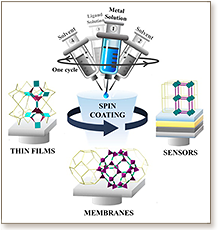

 Here, we report a new and advanced method for the fabrication of highly oriented/polycrystalline metal–organic framework (MOF) thin films. Building on the attractive features of the liquid-phase epitaxy (LPE) approach, a facile spin coating method was implemented to generate MOF thin films in a high-throughput fashion. Advantageously, this approach offers a great prospective to cost-effectively construct thin-films with a significantly shortened preparation time and a lessened chemicals and solvents consumption, as compared to the conventional LPE-process. Certainly, this new spin-coating approach has been implemented successfully to construct various MOF thin films, ranging in thickness from a few micrometers down to the nanometer scale, spanning 2-D and 3-D benchmark MOF materials including Cu2(bdc)2·xH2O, Zn2(bdc)2·xH2O, HKUST-1, and ZIF-8. This method was appraised and proved effective on a variety of substrates comprising functionalized gold, silicon, glass, porous stainless steel, and aluminum oxide. The facile, high-throughput and cost-effective nature of this approach, coupled with the successful thin film growth and substrate versatility, represents the next generation of methods for MOF thin film fabrication. Therefore, paving the way for these unique MOF materials to address a wide range of challenges in the areas of sensing devices and membrane technology.
Here, we report a new and advanced method for the fabrication of highly oriented/polycrystalline metal–organic framework (MOF) thin films. Building on the attractive features of the liquid-phase epitaxy (LPE) approach, a facile spin coating method was implemented to generate MOF thin films in a high-throughput fashion. Advantageously, this approach offers a great prospective to cost-effectively construct thin-films with a significantly shortened preparation time and a lessened chemicals and solvents consumption, as compared to the conventional LPE-process. Certainly, this new spin-coating approach has been implemented successfully to construct various MOF thin films, ranging in thickness from a few micrometers down to the nanometer scale, spanning 2-D and 3-D benchmark MOF materials including Cu2(bdc)2·xH2O, Zn2(bdc)2·xH2O, HKUST-1, and ZIF-8. This method was appraised and proved effective on a variety of substrates comprising functionalized gold, silicon, glass, porous stainless steel, and aluminum oxide. The facile, high-throughput and cost-effective nature of this approach, coupled with the successful thin film growth and substrate versatility, represents the next generation of methods for MOF thin film fabrication. Therefore, paving the way for these unique MOF materials to address a wide range of challenges in the areas of sensing devices and membrane technology.